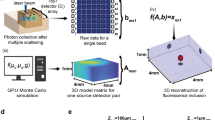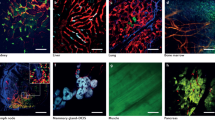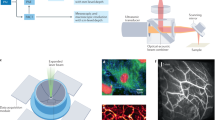Abstract
We report a technique to evaluate the same tumor microenvironment over multiple intravital imaging sessions in living mice. We optically marked individual tumor cells expressing photoswitchable proteins in an orthotopic mammary carcinoma and followed them for extended periods through a mammary imaging window. We found that two distinct microenvironments in the same orthotopic mammary tumor affected differently the invasion and intravasation of tumor cells.
This is a preview of subscription content, access via your institution
Access options
Subscribe to this journal
Receive 12 print issues and online access
$259.00 per year
only $21.58 per issue
Buy this article
- Purchase on Springer Link
- Instant access to full article PDF
Prices may be subject to local taxes which are calculated during checkout


Similar content being viewed by others
References
Condeelis, J. & Segall, J.E. Nat. Rev. Cancer 3, 921–930 (2003).
Gupta, G.P. & Massague, J. Cell 127, 679–695 (2006).
Sidani, M. et al. J. Mammary Gland Biol. Neoplasia 11, 151–163 (2006).
Lehr, H.A. et al. Am. J. Pathol. 143, 1055–1062 (1993).
Wyckoff, J.B. et al. Cancer Res. 67, 2649–2656 (2007).
Bins, A.D. et al. BMC Biotechnol. 7, 2 (2007).
Gurskaya, N.G. et al. Nat. Biotechnol. 24, 461–465 (2006).
Lukyanov, K.A., Chudakov, D.M., Lukyanov, S. & Verkhusha, V.V. Nat. Rev. Mol. Cell Biol. 6, 885–891 (2005).
Gray, N.W., Weimer, R.M., Bureau, I. & Svoboda, K. PLoS Biol. 4, e370 (2006).
Sato, T., Takahoko, M. & Okamoto, H. Genesis 44, 136–142 (2006).
Hatta, K., Tsujii, H. & Omura, T. Nat. Protoc. 1, 960–967 (2006).
Post, J.N., Lidke, K.A., Rieger, B. & Arndt-Jovin, D.J. FEBS Lett. 579, 325–330 (2005).
Chudakov, D.M., Lukyanov, S. & Lukyanov, K.A. Nat. Protocols 2, 2024–2032 (2007).
Condeelis, J. & Pollard, J.W. Cell 124, 263–266 (2006).
Lin, E.Y. et al. Am. J. Pathol. 163, 2113–2126 (2003).
Acknowledgements
This work was supported by US Department of Defense (BC061403 to D.K.), US National Institutes of Health (U54GM064346 to J.v.R.; CA100324 to J.C., J.E.S. and J.W.; U54CA126511 to J.C. and B.G.; and GM070358 and GM073913 to V.V.V.). We thank the staff of the Analytical Imaging Facility and D. Entenberg for help with microscopy, the immunohistochemistry facility for help with histology, M. Rottenkolber for help in fabrication of the imaging box, J. Pollard (Albert Einstein College of Medicine) for providing the F4/80 antibody, S. Garofalo for technical assistance, and members of the Condeelis, Segall, Cox and Verkhusha laboratories for discussions.
Author information
Authors and Affiliations
Corresponding authors
Supplementary information
Supplementary Text and Figures
Supplementary Figures 1–4, Supplementary Methods (PDF 778 kb)
Supplementary Movie 1
Movie recorded through the ocular, at low magnification (10×). After focusing the field and checking for the flowing vessels in the green epifluorescence channel, the photoswitched area can be recognized in the red channel. (MOV 803 kb)
Supplementary Movie 2
120-minute timelapse of a 250 × 250 µm area photoswitched inside the tumor. Notice the cells which move towards the fast flowing vessel. Non-photoswitched cells (green), photoswitched cells (red) and matrix (blue). (MOV 2261 kb)
Supplementary Movie 3
Z-stack of collagen (blue) and Dendra2-MTLn3 tumor cells (green and red) visualized in the live animal using a multiphoton microscope. The stepsize is 5µm. (MOV 1644 kb)
Supplementary Movie 4
10-minute timelapse of flowing vessels labeled using AlexaFluo647-10K (red, moving shadows are red blood cells) and Dendra2-MTLn3 tumor cells (green). Other channels were omitted for better contrast. (MOV 708 kb)
Rights and permissions
About this article
Cite this article
Kedrin, D., Gligorijevic, B., Wyckoff, J. et al. Intravital imaging of metastatic behavior through a mammary imaging window. Nat Methods 5, 1019–1021 (2008). https://doi.org/10.1038/nmeth.1269
Received:
Accepted:
Published:
Issue Date:
DOI: https://doi.org/10.1038/nmeth.1269
This article is cited by
-
Intravital measurements of solid stresses in tumours reveal length-scale and microenvironmentally dependent force transmission
Nature Biomedical Engineering (2023)
-
Intravital imaging to study cancer progression and metastasis
Nature Reviews Cancer (2023)
-
Multiphoton intravital microscopy of rodents
Nature Reviews Methods Primers (2022)
-
Role of Lymphatic Endothelium in Vascular Escape of Engineered Human Breast Microtumors
Cellular and Molecular Bioengineering (2022)
-
Intravital microscopy of dynamic single-cell behavior in mouse mammary tissue
Nature Protocols (2021)



